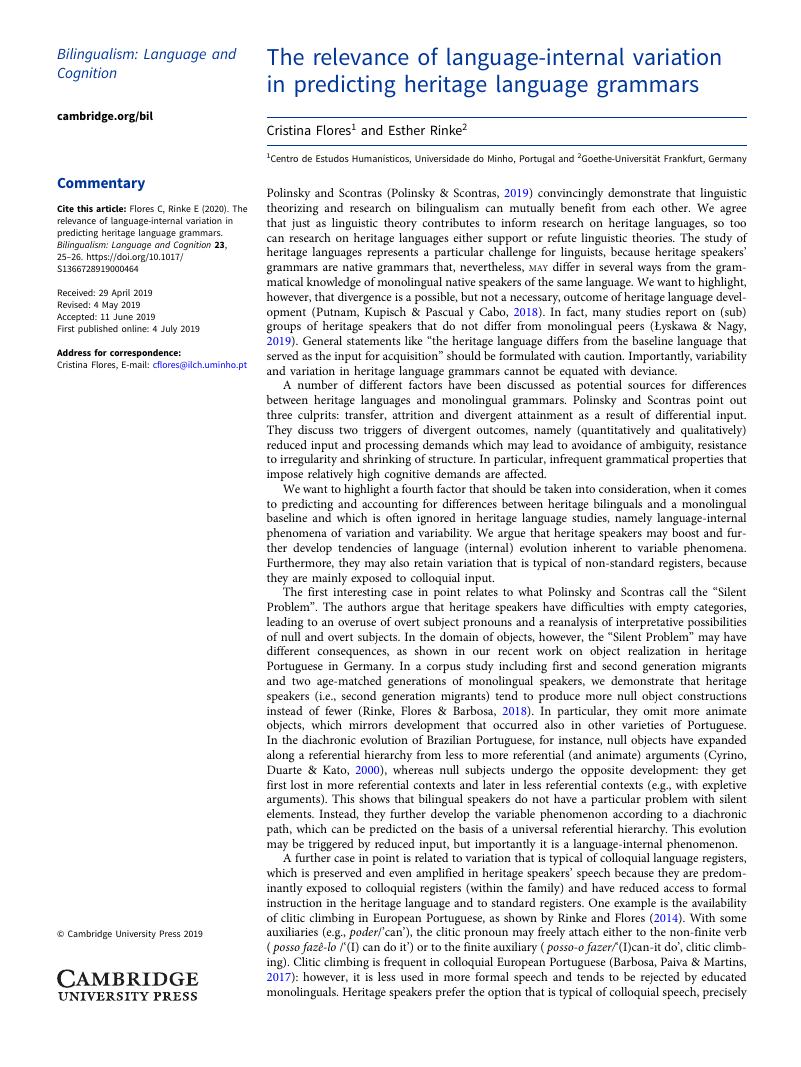Crossref Citations
This article has been cited by the following publications. This list is generated based on data provided by Crossref.
Abutalebi, Jubin
and
Clahsen, Harald
2020.
Heritage languages, infants’ language recognition, and artificial grammars for bilingualism research.
Bilingualism: Language and Cognition,
Vol. 23,
Issue. 1,
p.
2.
López-Beltrán, Priscila
and
Carlson, Matthew T.
2020.
How usage-based approaches to language can contribute to a unified theory of heritage grammars.
Linguistics Vanguard,
Vol. 6,
Issue. 1,
Gagarina, Natalia
and
Milano, Alessandra
2021.
Handbook of Early Language Education.
p.
1.
Meisel, Jürgen M.
2021.
Diversity and divergence in bilingual acquisition.
Zeitschrift für Sprachwissenschaft,
Vol. 40,
Issue. 1,
p.
65.
Umbal, Pocholo
and
Nagy, Naomi
2021.
Heritage Tagalog Phonology and a Variationist Framework of Language Contact.
Languages,
Vol. 6,
Issue. 4,
p.
201.
Rinke, Esther
and
Flores, Cristina
2021.
Portuguese as Heritage Language in Germany—A Linguistic Perspective.
Languages,
Vol. 6,
Issue. 1,
p.
10.
Bayram, Fatih
Pisa, Grazia Di
Rothman, Jason
and
Slabakova, Roumyana
2021.
The Cambridge Handbook of Heritage Languages and Linguistics.
p.
545.
2021.
The Cambridge Handbook of Heritage Languages and Linguistics.
p.
373.
Uygun, Serkan
and
Clahsen, Harald
2021.
Morphological processing in heritage speakers: A masked priming study on the Turkish aorist.
Bilingualism: Language and Cognition,
Vol. 24,
Issue. 3,
p.
415.
Shin, Naomi
2022.
Structured variation in child heritage speakers' grammars.
Language and Linguistics Compass,
Vol. 16,
Issue. 12,
Gagarina, Natalia
and
Milano, Alessandra
2022.
Handbook of Early Language Education.
p.
83.
Lai, Li-Fang
and
Gooden, Shelome
2022.
Language Contact, Language Ecology, and Intonational Variation in the Yami Community.
Language and Speech,
Vol. 65,
Issue. 4,
p.
791.
Wiese, Heike
Alexiadou, Artemis
Allen, Shanley
Bunk, Oliver
Gagarina, Natalia
Iefremenko, Kateryna
Martynova, Maria
Pashkova, Tatiana
Rizou, Vicky
Schroeder, Christoph
Shadrova, Anna
Szucsich, Luka
Tracy, Rosemarie
Tsehaye, Wintai
Zerbian, Sabine
and
Zuban, Yulia
2022.
Heritage Speakers as Part of the Native Language Continuum.
Frontiers in Psychology,
Vol. 12,
Issue. ,
Martínez Vera, Gabriel
López Otero, Julio César
Sokolova, Marina Y.
Cleveland, Adam
Marshall, Megan Tzeitel
and
Sánchez, Liliana
2023.
Aspectual se and Telicity in Heritage Spanish Bilinguals: The Effects of Lexical Access, Dominance, Age of Acquisition, and Patterns of Language Use.
Languages,
Vol. 8,
Issue. 3,
p.
201.
Klassen, Rachel
Lundquist, Björn
and
Westergaard, Marit
2023.
L1 Grammatical Gender Variation through the Representation in the Lexicon.
Journal of Psycholinguistic Research,
Vol. 52,
Issue. 2,
p.
359.
Shin, Naomi
Cuza, Alejandro
and
Sánchez, Liliana
2023.
Structured variation, language experience, and crosslinguistic influence shape child heritage speakers’ Spanish direct objects.
Bilingualism: Language and Cognition,
Vol. 26,
Issue. 2,
p.
317.
Requena, Pablo E.
2023.
Variation versus deviation.
Linguistic Approaches to Bilingualism,
Vol. 13,
Issue. 6,
p.
801.
Georgiou, Georgios P.
and
Giannakou, Aretousa
2024.
Acoustic Characteristics of Greek Vowels Produced by Adult Heritage Speakers of Albanian.
Acoustics,
Vol. 6,
Issue. 1,
p.
257.
Rinke, Esther
Flores, Cristina
Oliveira, Priscila
and
Correia, Liliana
2024.
An experimental study on the loss of VS order in monolingual and bilingual speakers of Brazilian Portuguese.
Probus,
Vol. 36,
Issue. 1,
p.
77.
Shin, Naomi
2024.
Lifespan Acquisition and Language Change.
Vol. 14,
Issue. ,
p.
44.



